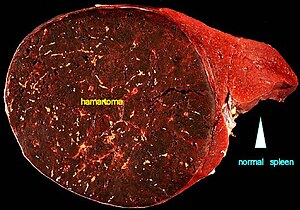Hamartomatous
| Hamartoma | |
|---|---|
 |
|
| A large hamartoma of the spleen. The hamartoma is the dark circular object on the left that dominates the image. This is a cross-section, the growth being about 9 cm in diameter, while the entire spleen is about 11 cm in diameter . | |
| Classification and external resources | |
| Specialty | medical genetics |
| ICD-10 | Q85.9 |
| ICD-9-CM | 757.32, 759.6 |
| DiseasesDB | 19785 |
| Patient UK | Hamartoma |
| MeSH | D006222 |
A hamartoma is a benign, focal malformation that resembles a neoplasm in the tissue of its origin. This is not a malignant tumor, and it grows at the same rate as the surrounding tissues. It is composed of tissue elements normally found at that site, but which are growing in a disorganized mass. They occur in many different parts of the body and are most often asymptomatic and undetected unless seen on an image taken for another reason (incidentaloma).
Additionally, the definition of hamartoma versus benign neoplasm is often unclear since both lesions can be clonal. Lesions such as hemangiomas, lymphangiomas, rhabdomyomas, adenomas and developmental cysts within the kidneys, lungs or pancreas are interpreted by some experts as hamartomas while others consider them true neoplasms. Moreover, even though hamartomas show a benign histology, it does not eliminate some rare but life-threatening clinical issues such as those found in tuberous sclerosis and neurofibromatosis type I.
Choristomas, forms of heterotopia, are closely related benign tumors, found in abnormal locations. The two can be differentiated as follows: a hamartoma is an excess of normal tissue in a normal situation (e.g. a birthmark on the skin), while a choristoma is an excess of tissue in an abnormal situation (e.g. pancreatic tissue in the duodenum).
Hamartomas result from an abnormal formation of normal tissue, although the underlying reasons for the abnormality are not fully understood. They grow along with, and at the same rate as, the organ from whose tissue they are made, and, unlike cancerous tumors, only rarely invade or compress surrounding structures significantly.
Hamartomas, while generally benign, can cause problems due to their location. For example, when located on the skin, especially on the face or neck, they can be very disfiguring. Cases have been reported of hamartomas the size of a small orange. They may obstruct practically any organ in the body, such as the eye, the colon, etc. They are particularly likely to cause major health issues when located in the hypothalamus, spleen, kidneys or lips.
...
Wikipedia
